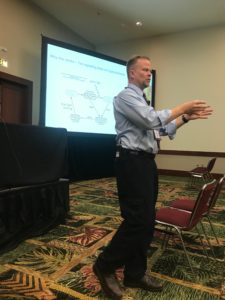Can art be used to teach elementary students that plants respond to environmental cues? How can museums make learning about plant evolution more fun? Does writing and editing Wikipedia articles increase student engagement in science writing? How can teachers use schoolyard woodlands to teach students about diversity? Can citizen science be used to demonstrate that wild animals do not have a preference against GMOs? These questions and more were addressed at the education and outreach concurrent symposium at Plant Biology 2017. An engaged group of plant scientists tore themselves away from the beautiful Hawaiian afternoon to discuss these and other important topics.

The session began with two presentations about educational tools targeted to K-12 students. ASPB award winner Kevin Folta (University of Florida) shared Veg-a-Sketch, a tool used to teach children about photomorphogenic development. This elegant system allows students aThe students apply stencils and return the plants to white light to restore the accumulation of purple anthocyanin pigments in the leaves. The regions of leaf blocked by the stencil remain green, allowing the students to create artistic designs while learning about cryptochrome responses and plants’ developmental responses to abiotic stimuli. In addition to the obvious use of this tool to allow students to explore biological responses, Folta also discussed his hope that students would become more interested and thus eat more foods containing healthy pigments. Although Folta discussed usage of these tools in elementary classrooms, attendees shared ideas about inquiry-based activities that could be used to challenge undergraduate students as well. These kits will be available to schools, and information can be found at www.veg-a-sketch.com.
Mario De Tullio (University of Bari) then discussed his creation and usage of three interactive games to teach museum visitors about plant evolution. The games are presented to the students following their exploration of more traditional museum exhibits. The animations were professional and engaging and featured a simple drag-and-drop design with content repetition to reinforce concepts. He reported that students enjoyed playing the games and were able to navigate topics ranging from evolution, biodiversity, and gene expression using the ABC model of flower development. Although these resources are currently only available in Italian, De Tullio discussed his desire to develop similar games in English, and the attendees spent most of the Q&A portion of the presentation discussing possible modes of implementation and suggesting additional content.
Alan Berkowitz (Cary Institute of Ecosystem Studies) shifted the discussion to teacher education, presenting the results of a project funded by a 2014 BLOOME grant. To increase science literacy in schools and decrease plant blindness, this project features teacher training (in the form of five teacher fellows and 19 field test teachers to date) and corresponding classroom curriculum. The teaching modules used schoolyard woodlands to demonstrate themes including dispersal, growth strategies, herbivory, and decomposition. By utilizing a top-down approach (the teaching fellows trained additional teachers, who then taught their students), the program has reached a large number of students. To date, students have demonstrated improved recognition of diversity and the influence of species on the environment as a result of this program.
Squirrels won’t eat it, so why should we? This unsubstantiated claim is one of many used to validate anti-GMO sentiments. Karl Haro von Mogel (Biology Fortified, Inc.) tested this claim using the power of citizen science. The crowdfunded project investigating whether wild animals prefer non-GMO corn (spoiler: they don’t, but they do love corn!). The experiment was massively successful on many fronts: the project was fully funded (and then some), supplies were secured and provided to participants, controls were included, and 442 experiments were completed. Experimenters ranged from interested individuals and those who hoped to demonstrate (or disprove) a relationship between GM corn and animal preference. Although the results of this study were unsurprising to most attendees, the impact is wide-ranging. One take-home from this presentation was that research can also serve as outreach; these types of studies can generate publishable data, teaching resources, and citizen scientists who become scientific advocates as a result of being involved in the scientific process.
